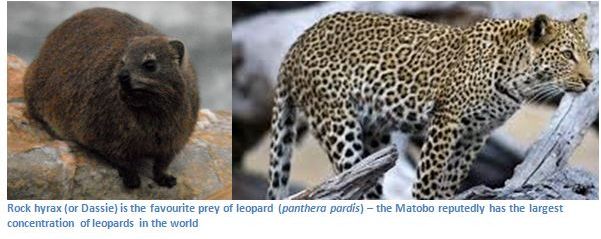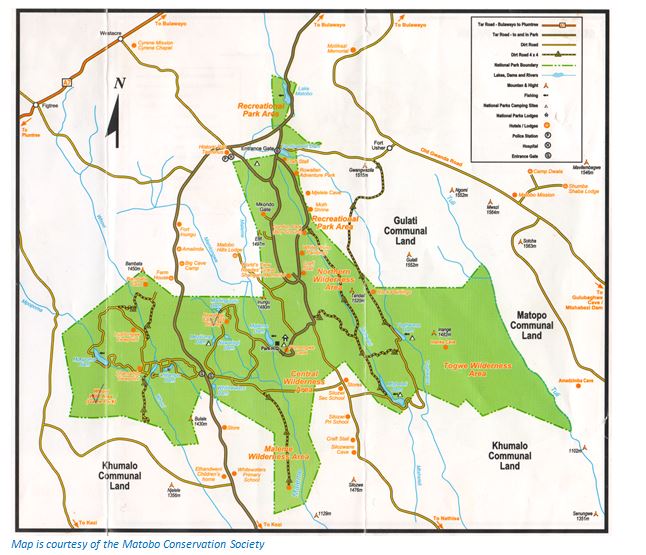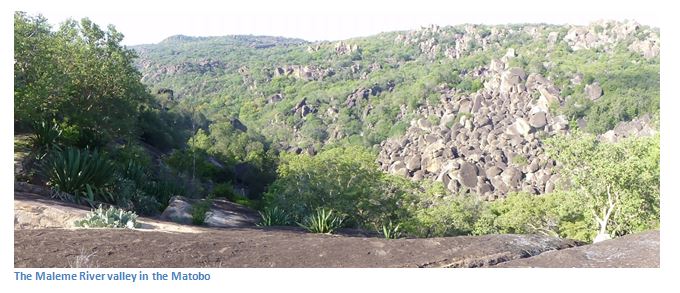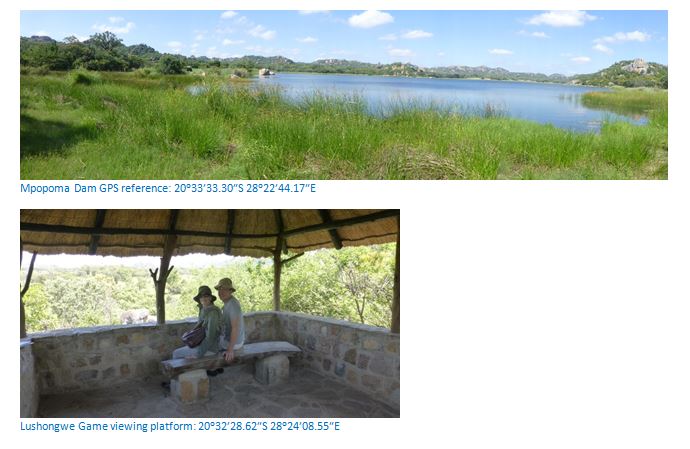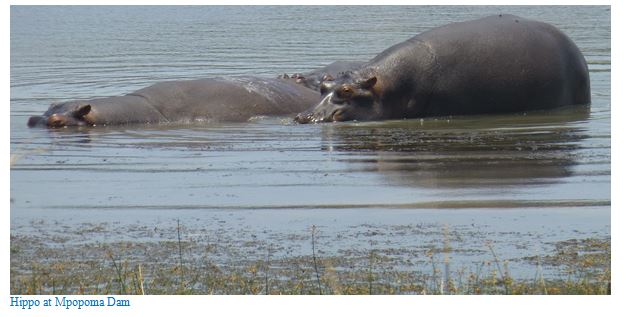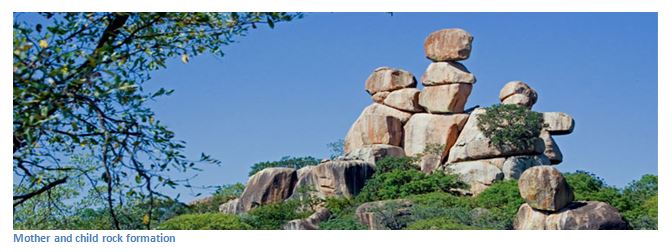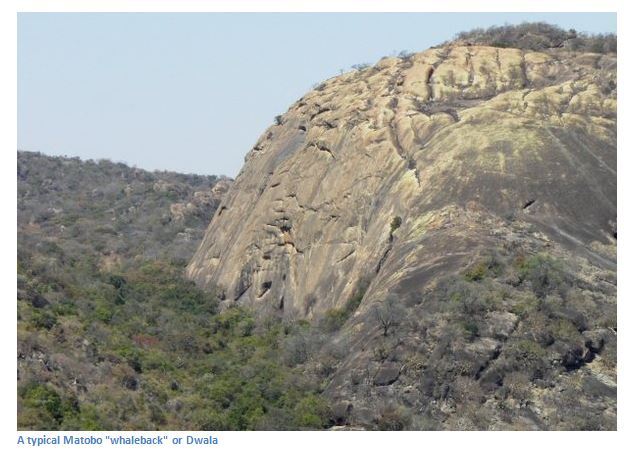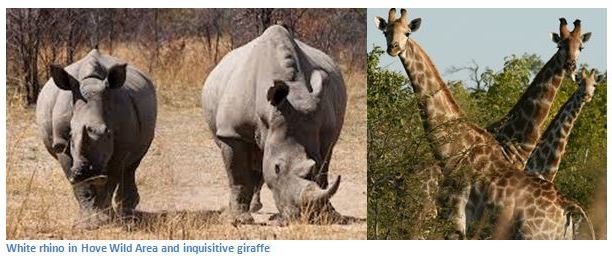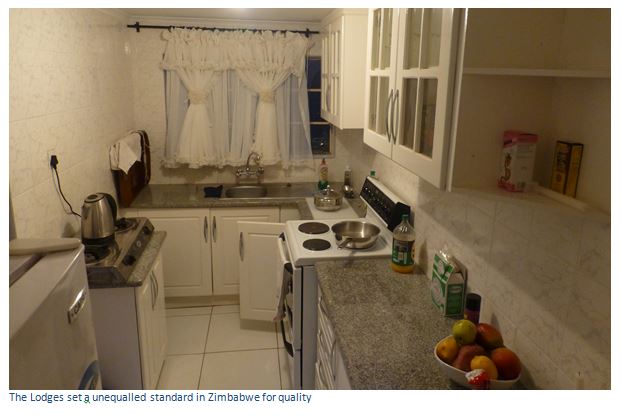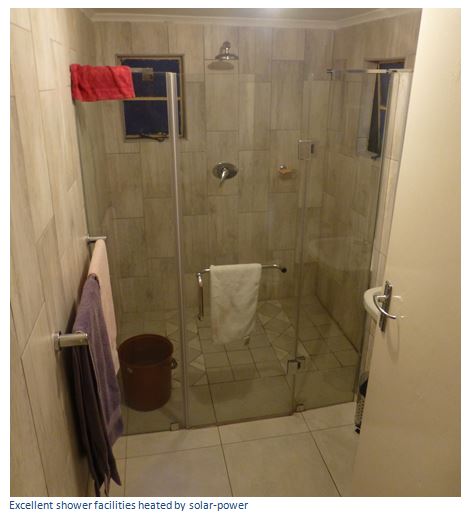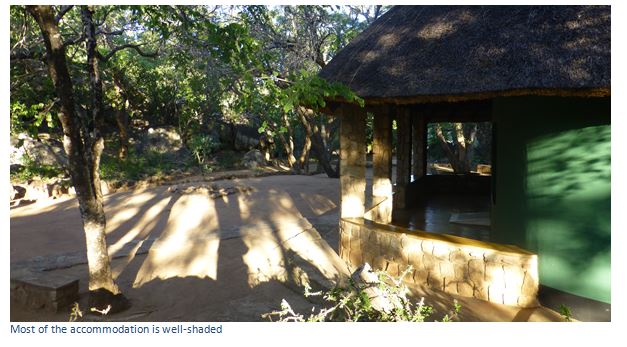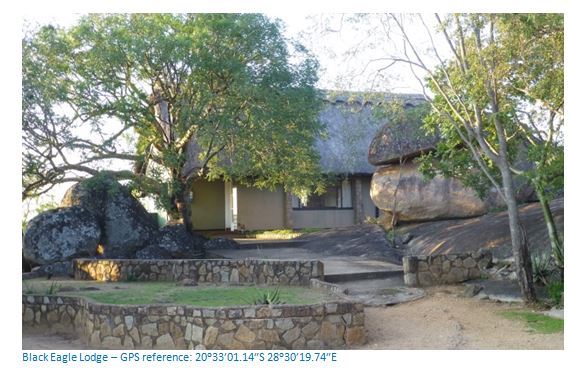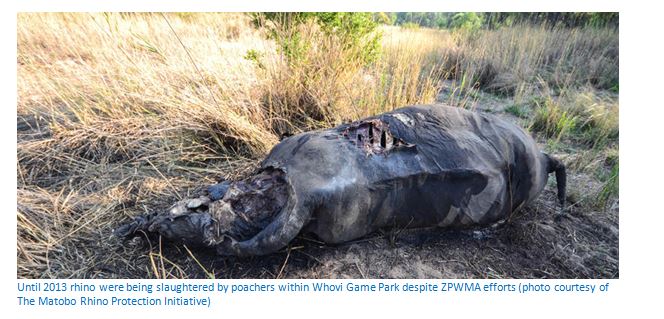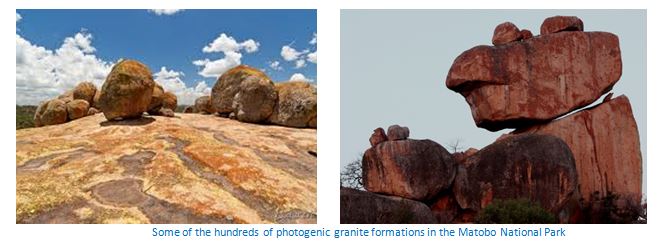Matobo National Park, a UNESCO World Heritage Cultural Site
- Matobo National Park makes a great stopover for visitors in transit by road to Hwange and Victoria Falls and is only forty kilometres from Bulawayo.
- The largest concentrations of black and white rhinoceros in Zimbabwe making it easy to spot one or more of the large population of this endangered species during a visit.
- Over 3,000 known San rock art sites including Nswatugi Cave, White Rhino Shelter and nearby Bambata Cave, Inanke Cave and Silozwane Cave just outside the park.
- A wide variety of accommodation in lodges, chalets or camping, or in luxury at the nearby private lodges.The accommodation facilities here far exceed the standard at any other ZWMA National Park and management deserves commendation for their attention to detail.
- Numerous cultural and historical sites either within, or surrounding the National Park and still retains great cultural significance for many local people.Also, the only National Park to replace the old Rhodesian-style wood burning boilers with solar power in all accommodation.
- The Matobo comprises a unique landscape with amazing balancing rocks
- Cecil John Rhodes is buried at the site he described as having a “view of the World.”
From Bulawayo take Robert Mugabe Way in the city, this turns into Matopos Road which continues south 30 kilometres to the National Park boundary. The two-lane tarred road continues as a single lane tarred road to Maleme Dam and Rest Camp. The remaining roads in the park are gravelled, but suitable for most vehicles. Whovi Wild Area Game Park requires high clearance and preferably 4WD.
GPS reference for Matobo National Park HQ: 20⁰33′24.05″S 28⁰31′02.78″E
The Matobo National Park is situated within the sprawling Matobo Hills, a range of granite domes and balancing rock formations which have undergone millions of years of erosion and weathering leaving an imposing rugged terrain dominated by huge granite whaleback mountains and where the diversity of the vegetation including mopane, acacia, brachystegia, ficus, Azanza, ziziphus, Strychnos and Terminalia supports a wide range of wildlife. This dramatic landscape plus a long historical and cultural association with early man make for a dramatic and beautiful place to visit and rightly deserved its nomination as a World Heritage Site in 2003.
The Matobo National Park forms the core of the Matobo (this being the correct vernacular pronunciation of the area) or Matopos Hills, covering an area of about 3,100 square kilometres, of which 424 square kilometres is National Park; the remainder being largely communal land and a small proportion of commercial farmland. Mzilikazi, founder of the Ndebele nation, gave the area its name, meaning “Bald Heads” and he is buried in the Matobo Hills just a short distance north east from the Park.
The National Park is the oldest in Zimbabwe, established in 1926 as Rhodes Matopos National Park, a bequest from Cecil rhodes. The original Park borders extended well to the south and east of the current Park but these areas were designated for settlement; subsequently the Park area increased with the acquisition of World's View and Hazelside farms to the north.
Activities
Visitors can visit the ZPWMA Reception for details of escorted walks, fishing licences or condition of the roads.
Game viewing
Some game can be seen throughout the park, with regular sightings of white and black rhino, sable antelope and impala with the best viewing is to be had in the 105 square kilometres Whovi, or Hove Wild Area Game Park, in the west of the National Park. This game park was established with translocated animals from the border areas of Hwange National Park, other animals include giraffe, zebra, wildebeest, ostrich and sometimes leopard.. There are two game viewing hides.As already mentioned the entire area was extensively poached during the land invasions, but the fence, better dialogue with local communities surrounding the National Park and the fence should improve the game count. One criticism would be the dustbins at sites such as Mpopoma Dam are overflowing and should be emptied more regularly.
Hiking
With beautiful scenery, pleasant climate and safe environment, Matobo offers excellent hiking country. Shorter hikes and walks include:
- Lakeside walk, Maleme Dam, from Fish Eagle lodge
- Mount Pomongwe, near Maleme Camp gives good views over the central part of the Park
- Maleme Camp to Pomongwe Cave rock paintings.
Longer hikes include:
- Climbing Mount Shambashawa, near Gordon Park
- Climbing Nyahwe Mountain
- Hike from Toghwana Dam to Inanke Cave and rock paintings
- Accompanied hikes for up to six people with an armed game scout are available from Maleme Rest Camp
Trail riding / Horse riding
Supervised horse trails are arranged by the Parks and Wildlife staff. There are two routes:
- From Maleme Camp and visiting scenic locations in the Maleme valley and environs.
- From Whitewaters Office into the Whovi Wild Area for game viewing.
Running
The 33 miler road race is run annually in the park.
Fishing
The many dams in the park allow for enjoyable fishing, notably for tilapia and bass, without the risk of crocodiles. Bass were stocked into seven of the Parks dams from the research station at Maleme Dam. The park entry fee includes a fishing license.
Boating
Boating is possible on the larger dams, such as Maleme, Mthselele, Toghwana and Lake Matopos with privately owned boats permitted.
Bird watching - offers great opportunity to see the several eagle species
Animals
- Matobo National Park has a wide diversity of animal species with 175 bird, 88 mammal, 39 snake and 16 fish species recorded. The Park is designated as an Intensive Protection Zone for white and black rhinoceros; the white restocked from Kwa-Zulu Natal in the 1960’s and the black from the Zambezi Valley in the 1990’s. Other mammals include zebra, sable, tsessebe,wildebeeste, giraffe, kudu, eland, klipspringer, impala, hyena, cheetah, hippo, warthog, waterbuck, wildcat, common duiker, klipspringer, crocodiles, baboons, vervet monkeys, ostrich and leopard. However the land invasions of 2000 brought havoc from the adjoining communal lands and wildlife sightings are infrequent at present. However, the outlook is now much improved with better management and more anti-poaching patrols and the wildlife population should improve. On a recent visit we were disappointed to see the large number of cattle within the National Park.
- The park contains the world's densest population of leopard due to the abundance of rock hyrax, which make up 50 per cent of their diet.
- Matobo National Park also contains the world’s highest concentration of breeding pairs of black eagles. Other Bird species that can be found include the fish eagle and martial eagle, francolin, secretary bird, weavers, pied crow and Egyptian geese. Many migratory birds spend the European winter here.
- Fish species commonly found include bass, bottle fish, bream, catfish and robustus.
Flora
The Matobo Hills has mixed and diverse vegetation with over 200 types of trees recorded, including mountain acacia, wild pear, paper bark tree and fig tree and ranging from Mopane, Acacia to Brachstegia species in other areas. There are also many aloes, wild herbs and over 100 grass species.
Rock Art
There are many excellent San rock art sites – the equal, or better than Mashonaland with many more examples of polychrome paintings and very complex ovoid shapes, or formlings.
Ndebele Cultural Village
Visiting the Ndebele cultural village is a great way to learn something about the traditions and culture of the local people and appreciate their traditional way of life whilst at the same time gaining their support for the visitors who come to enjoy the Matobo…this was land that belonged exclusively to the Ndebele from the 1830’s until 1893.
Geology
The Matobo Hills are composed entirely of crystalline granite which weathers into fantastic shapes, such as the balancing rocks known as Mother and Child Kopje. Between the granite kopjes are narrow swampy valleys known as dambos, or vleis because of the high rainwater runoff and they form the headwaters of the Maleme, Mpopoma and Mtsheleli and Thuli Rivers. The hills were formed over three thousand million years ago when molten materials deep within the earth’s crust slowly cooled. The softer rock above the granite was slowly worn away through wind and water erosion until the underlying granite was exposed leaving the smooth "whalebacks" or dwalas and the piles of rounded or square boulders broken “castle kopjes” we see today. All rocks contain natural lines of weakness called joints. The whalebacks are formed when layers of rock peel off like an onion skin along curved joints. The castle kopjes are formed by natural fractures, or joint lines splitting through erosion and leaving the natural boulders sitting one on top of another. The granite was not forced to the surface, nor did it ever flow like lava.
The granite has only a few intrusions of diabase, also called dolerite, a dark coloured igneous rock and veins of quartz. An interesting phenomena is the dolerite dyke, the so-called “iron wall” or “Shentendabudzi” which has been traced for over forty kilometres through the Matobo Hills, in parts is fourteen metres high and ten metres wide with practically vertical sides and is most spectacular at Gladstone Farm, eight kilometres from Matobo police Camp. The highest point is Gulati Mountain (1,549 metres) just outside the north-eastern corner of the National Park.
Accommodation and camping
Maleme Camp
This is the main camp in the centre of the park, and hosts the Park headquarters. All accommodation is self-catering and includes:
- Fifteen lodges, three are single-bedroomed, but all are fully equipped and electrified. Three lodges being Fish Eagle, Black Eagle and Imbila are classified as exclusive with upgraded fittings and fantastic views over the Maleme Gorge. The finishes of the lodge kitchens and bathrooms, the soft furnishings, cutlery, linen, china and furniture at Maleme Camp are the best in Zimbabwe and set a standard which all the ZPWA National Parks accommodation should try to attain.
- Six chalets, five have single bedrooms and one has two bedrooms; all are furnished except crockery and cutlery and have a communal kitchen and ablutions.
- Camping and caravan sites are situated along the eastern shores of Maleme Dam with cooking done on wood or charcoal braais and communal ablution and toilet facilities.
The following camps in the National Park offer camping and caravan sites with communal ablution and toilet facilities:
- Mtsheleli Camp, located in the south
- Mwesilume Camp, located on Circular Drive, west of Maleme Dam
- Toghwana Camp, located in the east
- Arboretum Camp, located in the west, near the Hazelside Office
- Sandy Spruit Camp, located in the east
- Lake Matopos Camp, located in the north
The Park authorities have plans to open the former conference centre as a restaurant during 2015.
Archaeological, historical and cultural Sites
A ten year study in the Journal Science carried out the biggest and most detailed study of 121 distinct populations of Africa and found the San people are one of fourteen known surviving DNA population groups from which modern humans evolved and their blood contains some of the oldest genetic markers on earth. They were the most genetically diverse group and may be the oldest human group on earth. Their DNA indicates they are directly descended from the original population of early human ancestors who gave rise to all other groups of Africans and, eventually, to the people who left the continent to populate other parts of the world.
San hunter gatherer artists lived here from about 13,000 to 2,000 years ago, leaving a rich heritage of over 3,000 registered rock art sites which probably constitutes the richest concentration in the world. White Rhino Shelter is a small site near Gordon Park, on the main tarred road through the National Park; the frieze includes the outline of both white and black rhinos, which is said to have inspired the re-introduction of the species in the 1960’s and a masterpiece herd of wildebeest in the top left corner. Other excellent rock art sites in the area include:
Pomongwe (GPS reference: 20⁰32′50.79″S 28⁰30′48.84″E)
Silozwane (GPS reference: 20⁰37′43.53″S 28⁰34′34.12″E)
White Rhino Shelter (GPS reference: 20⁰30′36.72″S 28⁰31′49.45″E)
Bambata car park (GPS reference: 20⁰30′26.07″S 28⁰24′42.89″E)
At Pomongwe Cave many thousands of stone tools were found, the oldest dating from the Middle Stone Age, animal remains showing the rock hyrax and tortoise as well as larger antelope formed part of the hunter gatherers diet. Sadly the rock art was damaged by a preservation attempt in the 1920’s using linseed oil. There are Site Museums at Pomongwe and Nswatugi.
The Matobo area has great spiritual and cultural significance to the local people and there are many sites within the park where important ceremonies still take place including rain-making at the Njelele shrine. Some scholars believe it is possible that the Mwari cult was initially established at Great Zimbabwe and that the move to Njelele could have been associated with a shift of the Rozvi administrative power from Great Zimbabwe to the Matobo Hills. In the 19th century, traditional priests were drawn from the ruling Venda and Kalanga families which were said to have been deeply entrenched in the Mwari cult tradition. Any visitors must be accompanied by the official priest or priestess, or his/her appointee. Songs of praise must be sung and during rainmaking ceremonies traditional beer was brought in clay pots and placed outside the shrine. The priest and messengers would step back a few metres from the shrine and a spokesperson would clap hands, praising and asking Mwari for rain. After a considerable time of clapping hands, praises and requests Mwari’s voice would be heard advising the priest and messengers on procedures and requirements for the requests to be granted.
The Iron Age is believed to have started about 2,000 years ago with the arrival of Bantu groups from the northwest and pushed out the San into more marginal lands in Botswana and the Kalahari. Their arrival is characterized by the start of agricultural settlements and villages with smelting and metal working evidenced by furnace sites. Much later during the Mfecane the Kalanga and Ndebele entered these hills from the south. Before the colonial era, the Matobo was the headquarters of the spiritualist oracle, the Mlimo. A great deal of the pottery and artefacts found on cave floors and most of the clay grain bins in the hills are remnants from the 1896 rebellion era.
The hills were the scene of the famous indaba between white settlers and Ndebele leaders in 1896—the second Matabele War, known in Zimbabwe as the First Chimurenga. Rhodes and a few colleagues rode alone and unarmed into this Ndebele stronghold and persuaded the Indunas to lay down their arms.
The Matobo Rhino Protection Initiative (www.rhodesmatopos.com)
In the early 1960s, thirteen white rhino were brought from South Africa to re-introduce the species back into the Matobo National Park and shortly afterwards a small group of black rhino were also introduced. The rhino bred well and in the late 1990’s, ZPWMA started to translocate rhino to other areas in the country. But from the year 2000 the rhino poaching problem began to increase in and in the last fifteen years there has been a dramatic decline in the population. In January 2013 concerned stakeholders formed the Matobo Rhino Initiative Trust whose objective was to assist ZPWMA with their rhino protection effort.
A section of the park is known as the Whovi Game Park has been designated by ZPWMA as an Intensive Protection Zone (IPZ) with a shoot to kill policy for poachers and asked if the Trust could re-fence this area as they wanted to confine the Rhino in a specific area so that their anti-poaching effort could be focused. Fence construction commenced in January 2013 and the entire fence of fifty-two Kilometres has been completed at a cost of US$180,000.
In conjunction with this effort the Dambari Trust have de horned all the rhino, black and white. Now would be poachers need to enter through a community supporting the ZPWMA programme, they enter an area where its likely anti-poaching units will be in close proximity to the rhino with a shoot to kill policy and all the rhino have been dehorned. In 2014 there have been poaching incursions which have all been thwarted and it was the first year in fifteen years that no rhino have been poached. Future intentions are to build on what has already been achieved, especially local community involvement.
Privately operated accommodation and camps bordering the Matobo National Park include:
Camp Amalinda (www.campamalinda.com) is a Safari lodge offering luxury accommodation with the surrounding rocks giving an impression that it has almost grown out of the landscape itself. There are nine thatched chalets, including two suites, individually designed and decorated, with polished concrete floors throughout decorated with rugs and mats. The large beds and mosquito nets are standard, as are en-suite bathrooms and a private seating area which provides a good place for writing postcards and the private balcony has views of the surrounding landscape. The main area at Camp Amalinda is linked to the chalets via pathways that meander through the boulders, wild fig and paper-bark thorn acacia. A cavernous lounge has comfortable and colourful cushioned sofas, a small library and bar area. Meals are communal and the large wooden dining table can comfortably cater for 18 guests. A large swimming pool built into the granite overlooks a waterhole.
Big Cave Camp (www.bigcavematopos.com) offers seven lodges of granite under thatch and separate camping facilities. Activities on offer at all these resorts include game drives, game walks, bird watching, tours to famous rock art galleries, as well as tours to Rhodes Grave site.
As befitting an area where Robert Baden-Powell honed his scouting knowledge in the 1890’s the Boy scouts have a camp called Gordon Park and the Girl guides have a camp site at Rowallan Park; both are in the north of the Mtsheleli Valley. Rowallan Camp (www.foreverafricansafaris.com)is a picturesque camp site nestled beneath a massive granite whaleback rock, just two Kilometres inside the Matopos Park. A new semi-permanent tented camp is due for completion in early 2015, but currently Rowallan operates as a luxury mobile tented camp comprised of East-African A-frame tents, each with en-suite bathroom (hot water, bucket showers and flush, or drop toilets). The camp operates without electricity and offers ambient paraffin and solar LED lighting.
Matobo Hills Lodge (www.matopohillslodge.com) is situated within a private wildlife reserve bordering Matobo National Park and offers affordable accommodation in thirteen twin-bedded and four double-bedded lodges with en-suite bathrooms. Meals are taken in a thatched dining room or open air gazebo and a swimming pool has been built into the granite to resemble a natural rock pool. A separate lounge / bar have spectacular 360⁰ views of Mount Ififi and the Maleme valley. Game drives can be taken into the Matobo National Park, or there are walks to the San rock painting sites and Rhodes’ grave at “World’s View.”
Farmhouse Lodge (www.farmhousematopos.com) is situated on a Private Wildlife Reserve, which borders the Rhodes Matopos National Park. The original Farm homestead was converted into a restaurant, bar and reception overlooking the pool garden. The Lodge offers all meals and prides itself on home cooked meals. Guests are accommodated in twelve individual cottages with bedroom, ensuite toilet / shower and open plan lounge with tea / coffee facility and fridge. The Lodge offers a variety of activities including horse trails and the popular rhino walks into the Whovi Game Park.
Hermits Peak Guest Lodge (zimsafaris@yoafrica.com) The Burton family who have been in tourism a long time renovated the first Lodge in the Matopos in the 1960’s. The lodge consists of nine upgraded rooms all en-suite and open plan dinning and bar area with campfire which surround a natural rock pool and indigenous Garden. Hermits Peak is situated two kilometres from the National Park boundary and as activities they offer tours and rhino walks.
Acknowledgements

